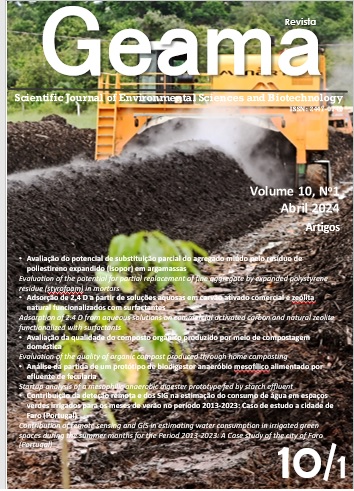Contribuição da deteção remota e dos SIG na estimação do consumo de água em espaços verdes irrigados para os meses de verão no período 2013-2023: caso de estudo a cidade de Faro (Portugal)
Keywords:
Espaços verdes, Índices de vegetação, Temperatura de Superfície, Índice de Humidade, Evapotranspiração de referência, Algarve, Consumo de águaAbstract
Mediterranean cities' green spaces are crucial in sustainability and urban organization. They are essential to promoting health, population well-being, preserving biodiversity, and adapting to climate change. In this context, the study aims to estimate the water consumption in the irrigated green spaces of Faro, Portugal, mainly occupied by grass, during the summer months from 2013 to 2023. This estimation is based on Reference Evapotranspiration and Landsat 8 satellite images from Google Engine. The Land Surface Temperature was determined using Thermal Band 10 and the Normalized Difference Vegetation Index. Irrigated green spaces were spatially identified through the Normalized Difference Water Index. The results showed that water use for irrigation was relatively low during the analyzed period. Even in 2023, when plant water needs were higher, only 4% of the total daily water consumption in Faro was allocated for irrigation. Therefore, water consumption aligns with the challenges of climate change. Considering that the municipality has only 5% of available green areas, it is imperative to raise awareness among stakeholders to implement more urban green spaces, preferably with native plants replacing lawns, to minimize irrigation needsDownloads
References
AYALA-AZCÁRRAGA, C., DIAZ, D., & ZAMBRANO, L. Characteristics of urban parks and their relation to user well-being. Landscape and urban planning, 189, 27-35, 2019.
BERTRAM, C., & REHDANZ, K. The role of urban green space for human well-being. Ecological Economics, 120, 139-152, 2015.
CARLSON, T. N., & RIPLEY, D. A. On the relation between NDVI, fractional vegetation cover, and leaf area index. Remote sensing of Environment, 62(3), 241-252, 1997.
CARRUS, G., SCOPELLITI, M., LAFORTEZZA, R., COLANGELO, G., FERRINI, F., SALBITANO, F., ... & SANESI, G. Go greener, feel better? The positive effects of biodiversity on the well-being of individuals visiting urban and peri-urban green areas. Landscape and urban planning, 134, 221-228, 2015.
GAO, B. C. NDWI—A normalized difference water index for remote sensing of vegetation liquid water from space. Remote sensing of environment, 58(3), 257-266, 1996.
GASSER, L., LE GALL, F., & ABILY, M. Water efficiency in smart cities: optimising irrigation for public green spaces. LHB, 110(1), 2294076, 2024.
GUO, J., NIU, H., XIAO, D., SUN, X., & FAN, L. Urban green-space water-consumption characteristics and its driving factors in China. Ecological Indicators, 130, 108076, 2021.
HUANG, S. K., LEE, S. W., JO, H. K., & YOO, M. Impact of frequency of visits and time spent in urban green space on subjective well-being. Sustainability, 11(15), 4189, 2019.
HUANG, C., YANG, J., LU, H., HUANG, H., & YU, L. Green spaces as an indicator of urban health: Evaluating its changes in 28 mega-cities. Remote Sensing, 9(12), 2017.
KONDO, M. C., FLUEHR, J. M., MCKEON, T., & BRANAS, C. C. Urban green space and its impact on human health. International journal of environmental research and public health, 15(3), 445, 2018.
KUHLEMANN, L. M., TETZLAFF, D., SMITH, A., KLEINSCHMIT, B., & SOULSBY, C. Using soil water isotopes to infer the influence of contrasting urban green space on ecohydrological partitioning. Hydrology and Earth System Sciences, 25(2), 927-943, 2021.
MARLOW, D. R., MOGLIA, M., COOK, S., & BEALE, D. J. Towards sustainable urban water management: A critical reassessment. Water Research, 47(20), 7150–7161, 2013.
NOURI, H., BORUJENI, S. C., & HOEKSTRA, A. Y. The blue water footprint of urban green spaces: An example for Adelaide, Australia. Landscape and urban planning, 190, 103613, 2019.
ROUSE, J. W., HASS, R. H., SCHELL, J. A., & DEERING, D. W. Monitoring the vernal advancement and retrogradation (Greenwave effect) of nature vegetation. Greenbelt,MD: NASA/GSFCT Type III Final Report, 1974.
SAJIB, M. Q. U., & WANG, T. Estimation of Land Surface Temperature in an agricultural region of Bangladesh from Landsat 8: Intercomparison of four algorithms. Sensors, 20(6), 1778, 2020.
SILVA, M. R. D. D. Planeamento de espaços verdes urbanos tendo por base a condução da rega e a deteção remota: caso de estudo-espaços verdes urbanos de São Brás de Alportel (Doctoral dissertation), 2017.
SKOKOVIC, D., SOBRINO, J. A., JIMENEZ-MUÑOZ, J. C., SORIA, G., JULIEN, Y., MATTAR, C., & CRISTÓBAL, J. Calibration and Validation of land surface temperature for Landsat8-TIRS sensor. LPVE (Land Product Validation and Evolution), 2014.
SOBRINO, J. A., JIMÉNEZ-MUÑOZ, J. C., & PAOLINI, L. Land surface temperature retrieval from LANDSAT TM 5. Remote Sensing of environment, 90(4), 434-440, 2004.
SOBRINO, J. A., JIMÉNEZ-MUÑOZ, J. C., SÒRIA, G., ROMAGUERA, M., GUANTER, L., MORENO, J., ... & MARTÍNEZ, P. Land surface emissivity retrieval from different VNIR and TIR sensors. IEEE transactions on geoscience and remote sensing, 46(2), 316-327, 2008.
Downloads
Published
How to Cite
Issue
Section
License
Copyright (c) 2024 Geama Journal - Environmental Sciences

This work is licensed under a Creative Commons Attribution-NonCommercial-ShareAlike 4.0 International License.
The Cultural Policies in Review applies the Creative Commons Attribution-Non-Commercial 4.0 International License for the works it publishes. This license was developed to facilitate open access - that is, free, immediate access, and unrestricted reuse of original works of all kinds. Our authors retain the copyright but, under that license, agree to leave the items legally available for re-use, without permission or fees, for almost any purpose. Any person may copy, distribute or reuse such articles, provided that the author and the original source (Cultural Policies in Review) are duly cited.





